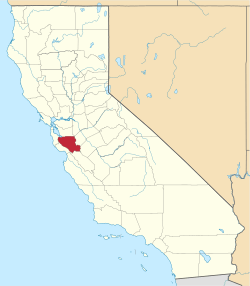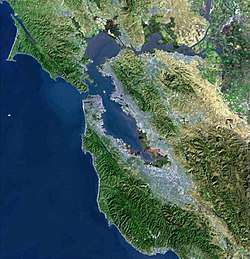San Antonio Valley, California
The community of San Antonio Valley, also called San Antonio or San Antone, is located along the Diablo Range in eastern Santa Clara County, California. The locale is bordered by Alameda County to the north and Stanislaus County to the east. The sparsely populated area is located at the junction of San Antonio Valley Road, Mines Road, and Del Puerto Canyon Road. The area includes the San Antonio Valley Ecological Reserve, a 3,282 acre nature preserve created by a Nature Conservancy purchase of land from local rancher, Keith Hurner, and known for its herd of tule elk.[2][3]
San Antonio Valley | |
|---|---|
 San Antonio Valley  San Antonio Valley | |
| Coordinates: 37.391709°N 121.490335°W | |
| Country | United States |
| State | California |
| County | Santa Clara |
| Time zone | UTC-8 (Pacific (PST)) |
| • Summer (DST) | UTC-7 (PDT) |
| ZIP code | 94550 |
| Area code(s) | 408 |
| GNIS feature ID | 232374[1] |
History and variant names
The San Antonio Valley appears to have been a transitional area between the native Ohlone cultures from the San Francisco-Monterey region and the Yokut of the San Joaquin River watershed. The Ohlone are speculated to have arrived in the Bay Area around 500 A.D. when they displaced Hokan speaking populations already in the region.[2]
On April 5, 1776, the de Anza Expedition called the area El Cañada de San Vicente.[4] The 1956 Thomas Brothers map spells it San Antone. This spelling mimics the way it is pronounced in common, modern usage by locals. It was spelled San Antone on the 1924 "Mount Boardman, California" U.S. Geological Survey 15-minute quadrangle.[5][6]:1–2
La Vereda del Monte traversed the valley on its way between the Sacramento River Delta and the Central Valley and was used by Joaquin Murrieta to transport stolen horses included among legally obtained mustangs taken by mesteñeros in the San Joaquin Valley. San Antonio Valley was one of the places along the Vereda where these horses were picked up from holding places nearby in Adobe Canyon and Isabel Valley.[7][8][6]:2–3, 431,432
The U.S. Postal Service established a Deforest Post Office in the area during 1892. It was moved within the area in 1897, 1906, and finally closed in 1909. Another 1924 map calls a group of buildings along San Antonio Creek, Deforest. The name comes from Ransford S. Deforest, the first Postmaster in the community.
Geography
The community lies in the San Antonio Valley, at elevation 2,133 feet (650 m).[1] The valley is traversed by San Antonio Creek, which flows northwesterward to Arroyo Valle, part of the Alameda Creek watershed.
Sphere of influence
The area is within the sphere of influence of three different counties. The flattest and easiest drive to town is via Mines Road to Livermore in Alameda County. Del Puerto Canyon Road leads 20- to 25-miles east to the area of Interstate 5 and the Stanislaus County community of Patterson. The steepest route out, San Antonio Road, climbs west toward University of California, Lick Observatory, topping out at around 4,200 ft (1,280 m). There it turns into State Route 130 and descends into San Jose in Santa Clara County.
Community
The community includes a CAL FIRE station at 47405 Mines Road. The station is called, Sweetwater - Station 25 and is part of the Santa Clara Ranger Unit, (Firescope mutual aid identifier SCU).
There is a restaurant at the junction of the three roads (Mines, San Antonio Valley, Del Puerto Canyon), appropriately called The Junction Bar and Grill. This restaurant serves as a community center as well as a stopping-off point for the many motorcycles, bicycles, and tourists that travel the roads.
Telephony
The area was served by manual telephone service until deregulation forced the arrival of dial service in the early 1980s. Prior to this, a non-dial Western Electric 1A1 coin telephone served on San Antonio Road about one mile east of the Observatory. Its telephone number was San Antonio California Toll Station Number 3. Today, wired telephone numbers for the area follow the format (408) 897-xxxx. The telephone utility serving this area today is Frontier Communications.
References
- "San Antonio Valley". Geographic Names Information System. United States Geological Survey.
- San Antonio Valley Ecological Reserve Draft Land Management Plan (Report). California Department of Fish and Wildlife. February 2016. Retrieved 2016-02-27.
- "Restoration of tule elk California success story". Billings Gazette. December 6, 2006. Retrieved 2016-02-27.
- Pedro Font (1913). The Anza Expedition of 1775-1776: Diary of Pedro Font. University of California. pp. 106–107. Retrieved 2016-02-28.
- Durham, David L. (2000). Durham's Place Names of the San Francisco Bay Area. Clovis, California: Word Dancer Press. p. 153.
- Frank F. Latta, JOAQUIN MURRIETA AND HIS HORSE GANGS, Bear State Books, Santa Cruz, California. 1980.
- "Isabel Valley". Geographic Names Information System. United States Geological Survey.
- Ron Erskine (5 Mar 2004). "Joaquin Murrieta slept here". Morgan Hill Times. Retrieved 24 Oct 2016.
Sources
- Santa Clara County Street Atlas, (1956 Edition), George Thomas.
Books about the area
Red Mountain: The Rise and Fall of a Magnesite Mining Empire, 1900-1947 by Robert W. P. Cutler, Morris Publishing, 2001, ISBN 0-9713235-0-X
I Made a Lot of Tracks by Phil Stadtler, CP Media, Bonanza, OR, 2007, ISBN 0-9759841-2-8
External links
- Map of San Antonio Valley
- CAL FIRE
- Area map (Nature Conservancy).
- This area is part of the Nature Conservancy Mount Hamilton Project.
- Unofficial photos of The Junction Café and area map
- Photographs of San Antonio Valley taken from the Lick Observatory from the Lick Observatory Records Digital Archive, UC Santa Cruz Library's Digital Collections

